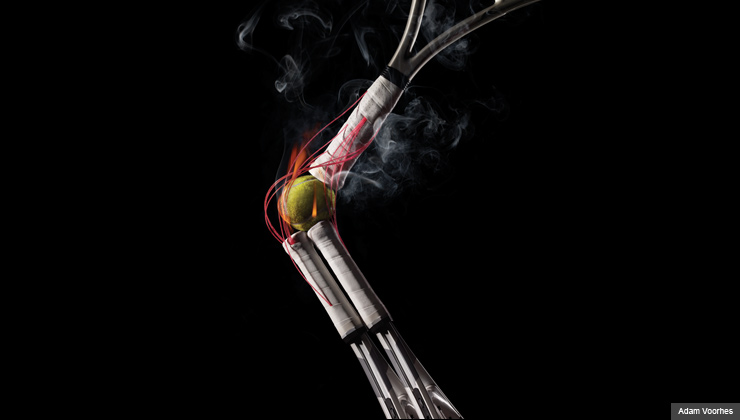AARP Hearing Center


My doubles partner and I lead the final set, my elbow on fire. Self-diagnosis: severe lateral epicondylitis, an inflammation of an extensor tendon commonly known as tennis elbow. I ignore the pain and hit a series of high-bouncing slice serves. With that, we win our first match since July.
My elbow, alas, refuses to join the celebration, and a week later I'm perched on the exam table of Gary Chimes, M.D., Ph.D., a specialist in musculoskeletal injuries at the UPMC Rehabilitation Institute in Pittsburgh.
I explain how tendinitis has so inflamed my elbow that home remedies no longer work. Perhaps he could give me a prescription NSAID (nonsteroidal anti-inflammatory drug) more potent than the over-the-counter versions?
Chimes smiles good-naturedly, no stranger to know-it-alls whose orthopedic knowledge is based on TV commercials for analgesics. Before I can babble further, he explains that inflammation is indeed the signature sign of tendinitis, but it's doubtful my elbow will show signs of it.
To find out, he holds an ultrasound device against the inside of my wrist. With each heartbeat, small red flowers bloom on the monitor. "This is what blood flow looks like," he says. Next, he moves the wand to my elbow. No flowers here. "If your elbow were really inflamed," he says, "we would see much more blood flow in the affected area."
As you may recall from high school biology, tendons are tough, inelastic bands that connect muscles to bones. They can be damaged in two basic ways: sudden trauma or long-term overuse.
"We used to think that both kinds of injury caused tendinitis," says Robert Dimeff, M.D., director of the sports medicine program at UT Southwestern Medical Center in Dallas. "Instead we're learning that the deterioration from accumulated small tears and frays in tendon tissue causes a condition better described as tendinosis."
The difference here is more than just suffixes. Tendinitis boosts blood flow to the injury, raises the local temperature and unleashes a pharmacopoeia of natural healing factors, dubbed the inflammatory soup. Some of these factors clear away the debris caused by trauma. Others sensitize nerves to induce protective pain, keeping us from more damage. Still others slowly rebuild what the injury has broken.
Tendinosis, by contrast, doesn't provoke a tidal surge of inflammatory soup. Instead, tendinotic tissues languish in a state of near neglect, as if our bodies don't fully recognize that an injury has taken place.
A small handful of tendons are especially susceptible to tendinosis, including the rotator cuff (swimmer's shoulder), the patellar tendon (runner's knee), the Achilles tendon (Achilles' heel), the medial epicondyle (golf elbow) and my own nemesis: the lateral epicondyle (tennis elbow).

































































More From AARP